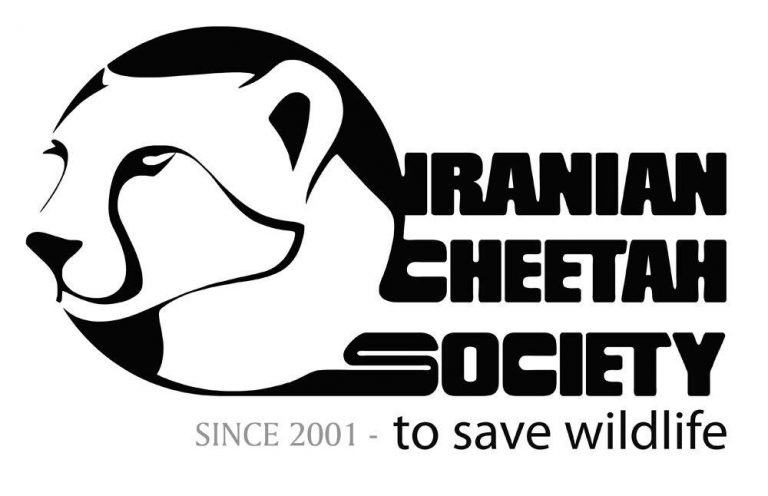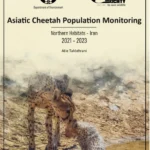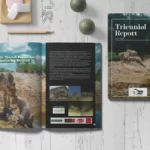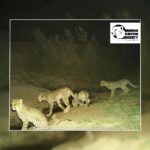Ehsan Moqanaki once spent two years taking pictures of a cat. It wasn’t just any cat, though: It was an Asiatic cheetah, a critically endangered mammal that used to roam across lands spanning from India to Turkey and the Arabian Peninsula. In a camera-trap study published in 2010, Moqanaki and other researchers set up cameras over miles of territory in Iran’s Kavir National Park and Kavir Protected Area to try to track the number of these rare felines left in the region.
What they found was 18 photos of the same male cat, sometimes nearly 40 miles between camera trap stations. That was surprising, because the ungulate-rich region should have been great territory for the graceful and speedy cats. But Moqanaki, a researcher with the Iranian Cheetah Society and the lead author of a study recently published in Animal Conservation, suspects that the cheetah population has dwindled over time in the Kavir areas due to a lack of connectivity. “This population has been isolated for some years,” he says.
The last time he was seen, in 2014, the male cheetah was likely around 10 years old. That means that he may have well died of natural causes by now, Moqanaki says. If so, to the best of researchers’ knowledge, he died alone.
The plight of the Asiatic cheetah illustrates an increasingly common conservation problem: fragmented territories. While bad for many species, highways, fences and other human constructions that divide up otherwise wild territory is particularly bad for long-ranging carnivores and migratory species like bison and elk, who need larger territories to track weather and seasonal food sources.
In the way of big cats, a prime example is the African cheetah, which has seen its habitat so curtailed by fences in recent years that it has been reduced to 10 percent of its range. Similarly, highways and roads in the Los Angeles area have isolated the puma population and forced the cats to inbreed, greatly harming their genetic diversity. Recently, conservationists have also warned that the Trump administration’s planned border wall could threaten the expansion of the jaguar back into the U.S. from Mexico.
The few dozen remaining Asiatic cheetahs—they could number anywhere from 50 to 100 wild individuals, depending on who’s doing the estimation—are holed up in some of the most remote terrain of the country. No more than a few dozen of these cats occupy a handful of core areas in present day Iran, which have become increasingly fragmented over the decades. The central Iranian desert tends to be semi arid or arid, with a spattering of shrubby foothills and more open landscapes.
Today, the handful of core remaining cheetah habitats are like islands surrounded by roads. “It’s very unlikely that these three core areas are connected at the moment,” says Moqanaki. So in 2015, he and Sam Cushman, a research ecologist with the U.S. Forest Service’s Rocky Mountain Research Station, set out to create a mathematical model that would allow them to predict the best possible wildlife corridors to connect these disparate populations.
The pair followed up on a study published earlier this year in Biodiversity and Conservation, which tracked cheetah mortality and the animals’ current distribution to find that out of 42 verified cheetah deaths in 2011 and 2012, a dozen were killed by road accidents. (On top of this, Moqanaki says he’s personally aware of a further three that were killed by vehicles since 2013.) Moqanaki and Cushman used models to predict the places where cheetahs were most likely to cross between these areas, and they correlated closely with areas where actual road kills occurred.
Aside from directly killing cheetahs, this encroachment of roads also means the few animals that are left are isolated from each other. “We don’t even end up with one interconnected population of 50 or so cheetahs, we end up with multiple populations where the risk to each of those subpopulations is elevated again,” says Luke Hunter, president and Chief Conservation Officer the global wild cat conservation organization, and a coauthor of the study that tracked cheetah deaths.
Hunter says Cushman is an amazing modelist, and that the recent study “basically confirms mostly what we know with data on the ground” in terms of major obstacles to cheetah recovery like roads and illegal hunting. According to Hunter’s recent study, humans hunting cheetahs is still the main source of cheetah mortality: Half of the 42 animals that were killed between 2011 and 2012 were from poaching, or killing by livestock herders or their dogs, though sometimes by accident.
The Asiatic (or Persian) cheetah subpopulation has only been separated from its African siblings for 30,000 to 40,000 years, according to Hunter. As seen in various artistic renderings, these cats were used by Indian rulers as hunting aids for hundreds of years; the 16th century Mughal ruler Akbar the Great was rumored to have possessed thousands of cheetahs for this end. Today, they are still closely related enough to their African cousins that they could likely still produce viable offspring if they bred together.
But Hunter says that importing new animals from Africa to bolster the struggling population wouldn’t solve the larger issue: an increasingly unsuitable, fractured habitat. “The main limitation to the cheetah population just taking off is really limitations in prey,” he says. “Cheetahs will breed like bunnies if you give them prey and space and remove the threats.”
Cheetahs evolved to be speedy in order to keep up with small, sprinting antelopes. But with the decline of these prey species, the cats have begun to rely on mountain prey that may be more liminal to their regular diet such as Persian ibex and urials, a type of wild sheep. The problem is, cheetahs don’t necessarily do well in the mountains, where they couldn’t compete with the cliffside agility of this prey, Hunter says.
Fortunately for the cats, many of these species cross through more cheetah-friendly valleys to drink water. “It’s really in that window that the cheetah is able to prey on those species,” he says. “We’ve actually learned from Iran that the cheetah can be a more versatile species because it’s clearly subsisting.” But this reliance on mountain species in the absence of gazelles is likely putting pressure on these cats Gazelle populations are recovering in some parts of the country, but these areas aren’t necessarily well connected to the core cheetah reserves.
Iran’s national conservation efforts collapsed after the country’s 1979 revolution, Moqanaki says, and then again during the brutal Iran-Iraq war throughout the 1980s. These political upheavals and an ensuing lack of support for conservation likely affected the cheetah’s plight directly, but Hunter says that gazelles and other local antelope populations that the cats rely on for food were hunted by Jeep and motorcycle during this time and underwent “catastrophic decline.”
Since 2001, Iran has renewed its commitment to conservation with programs like the Cheetah Project and efforts to conserve wetlands, and has put particular focus on species like cheetahs, Persian leopards, Persian wild asses and other species. Cheetahs in particular are very popular in Iran; the national football team has even adopted the animals as their logo and some refer to the team as “The Cheetahs.” “Now cheetahs in Iran are a symbol of wildlife conservation,” Moqanaki says.
Hunter says that the conservation decision, which involved an aggressive publicity campaign paired with the hiring of new park guards, motorcycles and other vehicles and other investments into protected areas, was key to the survival of cheetahs. “They averted extinction, they should be celebrated for that,” he says.
This has helped the population stabilize for now, but with numbers so small, Hunter says, the situation is still precarious. Asiatic cheetahs are extremely vulnerable to disease or other disasters.
For now, Cushman says that erecting fences, signs and other barriers to keep cheetahs off the roads could help, while Moqanaki says that developing cheetah-safe road crossings might provide some solution. He adds that the researchers have been closely following the efforts being conducted to connect fragmented cougar habitat in the Los Angeles area, with the hopes of replicating some of these techniques. “The cheetah society is trying to convince the Iranian government to develop an underpass,” he says.
Time is of the essence. If the Iranian government doesn’t invest more resource into connecting these populations, this subspecies of cheetah could be on an irreversible path towards extinction if nothing is done within five years, says Moqanaki. Some conservationists said last year that only two female cheetahs were photographed in the wild in a survey in 2015-2016 in multiple reserves in Iran.








